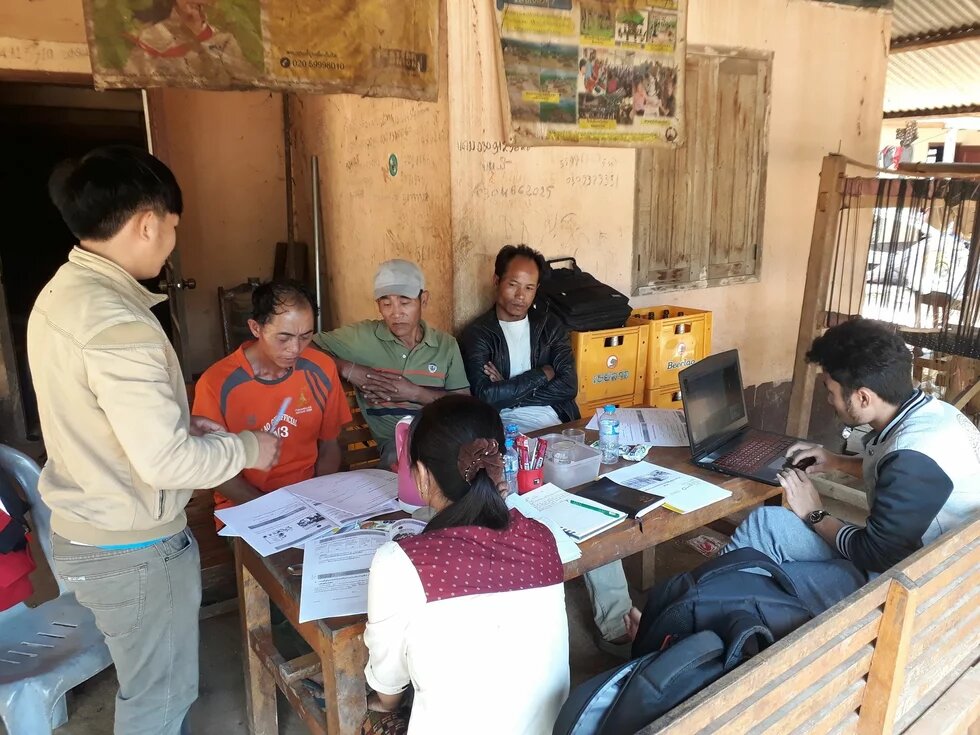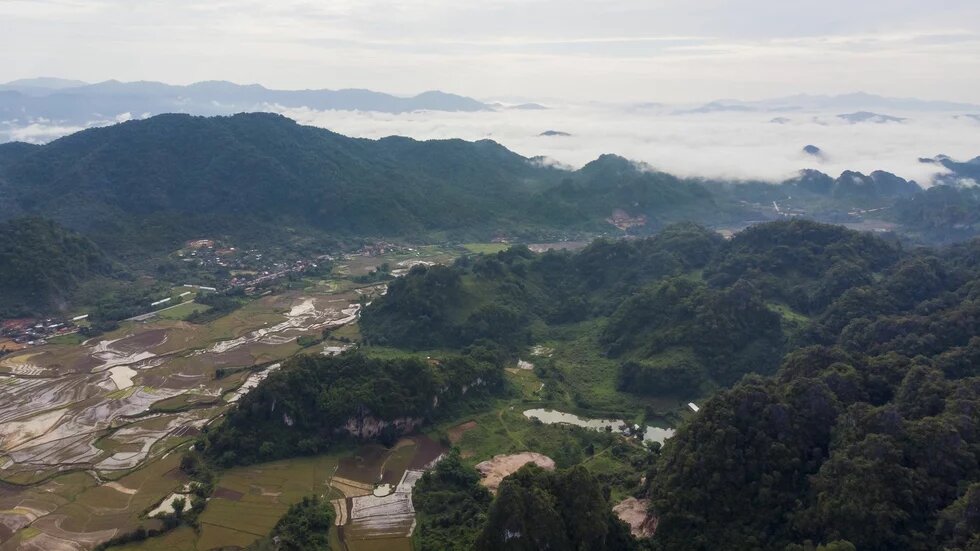
Despite the political, economic, and environmental challenges, non-state actors — such as the grassroots organizations, and non-profit associations — are creating a different atmosphere within the single-party system in Lao PDR through shared governance. Although the State considers shared governance as an “experimental phase,” positive impacts are already evident in the forests, wetland ponds, and watersheds, among others, in the provinces of Houaphanh, Luang Prabang, Phongsaly and Xiengkhouane.
By integrating local knowledge and the expertise of development facilitators, they are introducing new political dynamics that rebalance the roles of the State and the people in managing their natural resources. This article focuses on promoting shared governance to build resilience and foster equitable resource management, aiming to address the country’s challenges and to pave the way for better economic prospects.

Understanding governance in a single-party system
Lao PDR is one of the poorest countries in the world, with still over 62% of its population living in rural areas1 and being heavily dependent on agriculture and its vast natural resources. The country has been engaging in a long-term process of opening up to the market economy, approving and implementing several policies since the 2000s aimed to attract foreign investments to alleviate its worsening economic challenges2,3 Often, these policies rely on the development of natural resources which, paradoxically contradicts the national priority of preserving these resources2,4.
This contradiction, is understandable as the country needs to utilize one of its main (and few) comparative advantages —its abundant land, forest, and mineral reserves, to maintain regional relevance while addressing its fiscal challenges, such as debts, inflation, and depreciating currency. These policies part of the turning land into capital (TLIC)5,6 are manifested through land concessions for the development of hydroelectric and mining activities, as well as for the industrial production of cash crops. Although these generate revenues for the State, these have devastating effects to rural communities, who lack the economic or political clout to protect themselves from land grabbing and land concessions.
Due to the Laos Land Law7, which stipulates that all lands in Lao belongs to the State, the rights of villagers to their own lands are often not recognized. Hence, they risk being evicted from the public lands they occupy, or being forced to work for the companies to which these lands would be allocated. This lack of recognition of community rights and legitimacy marginalizes these actors in many decision-making processes. In this context, some development actors are mobilized to strengthen the capacities of communities to rebalance multi-actor relations while creating spaces for equitable negotiation for shared governance of the resources.
Fostering shared governance with the State in managing natural resources
As a one-party communist state, Laos is governed by the Lao People’s Revolutionary Party (LPRP). Despite efforts to decentralize, decision-making process remain at the LPRP at every level.
While the State acknowledges the need for greater allocation of responsibilities to non-state actors for managing their natural resources (particularly forest land, agriculture land, rivers and ponds, and watershed areas), there is still reluctance to include these non-state actors in the decision-making processes regarding how resources should be managed. These non-state actors, which primarily includes common people, private sector and localized civil society organizations who are directly or indirectly dependent on the different natural resources, are particularly impacted by the developed and imposed management mechanisms of their resources.
Therefore, efforts have been made by concerned civil society organizations along with development partners (International Non-Government Organizations (INGOS) and donors) to engage the existing power structures to support the greater inclusion of the non-state actors into the decision-making processes. To do so, this must first emphasize the economic and social benefits from responsible management of natural resources.
Critical first step is to convince the state actors to appreciate the positive impacts such as internal and geo-political stability associated with improved livelihoods, and improved state fiscal deficits of multi-actors’ mobilization and collective action. Only when state actors recognize these impacts will they likely to initiate and institute legislative and executive measures that afford greater participation of non-state actors. When combined with adequate support and orientation by development facilitators these developed institutional frameworks can open space for dialogue and discourses between the various state and non-state actors. Manifesting in different platforms such as multi-stakeholder workshops and policy dialogues bring together concerned state and non-state actors to share information, collectively analyze, and stimulate some form of collective action.
Given that we are working within a single-party system, patience and adaptability is needed to ensure such opened spaces are properly fostered before instigating in a multi-actor collective learning process that involve the co-development and co-implementation of some form of shared governance for natural resources. Critical to the processes is the ability to find the right settings and entry points to initiate dialogues and ignite multi-actor collective action.
This means continuous evaluation and reflection to maintain awareness of the ever-changing political dynamics of the state actors and their priorities as well as the myriad concerns of other non-state actors. This vigilance updates the perspectives and allows for adaptability while maintaining the relevance of the approach for different actors. Through the iterative trial-and-error collective learning process, issues are addressed, dynamic and systematic interactions are fostered, and these efforts culminate in concrete collective actions and shared governance mechanisms.
The experimentation and impact of developed shared governance mechanism are documented. This documentation and its exposition at policy makers’ platforms can validate the piloted shared governance mechanisms, potentially leading to acceptance by the State. The underlining principle is that any developed shared governance structure integrates systems and rules inherited from the past, with the state and non-state actors as principal actors in continuously adapting the organization and governance structure to local conditions, customs and rules. The creativity of local actors, particularly from the communities, is crucial for shaping organizational and governance systems, as long as it ensures sustainable and fair use of the resources. This creativity imbues resilience to the system.
Development facilitators, particularly those not from the local communities to which they support, are defined by their dual existence: that of facilitators fostering grass-roots mobilization for a shared governance and being an external entity, needing to learn and adapt for themselves the local contexts.
To harmonize this duality, they facilitate the processes in a subtle manner, and that is often not perceived, while maintaining a strong orientation toward supporting communities’ appropriation and realization their rights. This means encouraging community spaces that ultimately foster collective actions, like organized study tours, workshops and forum, allowing all actors to socialize, exchange experiences, and practices.
As these spaces are closely monitored, they are presented as spaces for collective learning and building socio-political capital with state actors while maintaining the purpose of supporting non-state actors’ actualization of their shared governance mechanisms. Trust between multi-actor dynamics may take time to establish, particularly as issues related to governance are heavily scrutinized. This trust is fragile and easily lost. Therefore, the facilitators’ primary focus is to maintain this crucial trust to drive the different transformations sought through the shared governance of resources.
Envisioning the future of shared resource governance in Laos
The author’s myriad experiences as a development facilitator, supporting shared governance mechanisms for non-state actors for different natural resources — forest, upland and lowland land, wetland, and watersheds) in different contexts (urban and rural), have afforded him the following perspectives. Considering the complex political, socio-economic and cultural complexities that exist in Laos, developing shared governance of resources involves that these processes are ongoing as the dynamics and conditions are constantly changing. It requires continuous persistence and emphasis on facilitating the collective learning processes, which helps strengthen the capacities of all actors, particularly—non-state actors — to collaboratively build solutions.
Perpetual building and fortification of this social construction is critical toward building non-state actors’ capacity and resilience while fostering their legitimacy. By leveraging the Lao government’s National Socio-Economic Development Plan’s (NSEDP) espoused objective of fair and sustainable natural resource management for poverty reduction and socio-economic development with greater allocation of rights to the people, it is possible to integrate the shared governance aspects as a way to support these national objectives.
As the policy makers increasingly recognize shared governance not as a threat to its political mandate but as providing alternative solutions to its various challenges, there is potentially greater latitude for socio-political experimentation. Combined with mobilizing the grass roots organizations such as the Non-Profit Associations (NPAs), a critical mass of motivated facilitators for the shared governance processes is emerging to strengthen the capacities of non-state actors while empowering them to take on greater roles in the country’s decision-making processes. However, shared governance initiatives need to remain vigilant and adaptable to the instability imposed by the country’s increasing economic woes that could be intensified by the country’s tendency toward strong authoritarian measures.
_
Phong A Huynh is a rural development and shared governance expert working for an international Non-Government Organization since 2012 in various capacities in Lao PDR. His roles have included SE Asia Geographical Focal Point for a Commons-based and shared governance program, team leader and project manager for various projects with heavy focus on supporting communities’ shared governance mechanisms in different thematic areas (agriculture, forestry, wetland and watershed) and contexts (urban, peri-urban and rural).
Disclaimer: This published work was prepared with the support of the Heinrich Böll Stiftung. The views and analysis contained in the work are those of the author and do not necessarily represent the views of the foundation. The author is responsible for any liability claims against copyright breaches of graphics, photograph, images, audio, and text used.
References
- From World Health’s Organization’s “Lao People’s Democratic Republic-WHO Country Cooperation Strategy 2024–2028” WPRO-2023-DPM-002-eng.pdf (who.int)
- Lao PDR, 9th National Socio-Economic Development Plan.
- Trade for Development Program from the National Implementation Unit of Department of Planning and Cooperation from Ministry of Industry and Commerce. T4D - Trade for Development - T4D (t4dlaos.org)
- National Action Plan for Bamboo and Rattan (2021-2025).
- CPI [Committee for Planning and Investment] 2006. National Socio-economic Development Plan (2006- 2010). Vientiane, Lao PDR
- Cornelia Hett, Vong Nanhthavong, Savanh Hanephom, Anongsone Phommachanh, Boungnong Sidavong, Ketkeo Phouangphet, Juliet Lu, Annie Shattuck, Micah Ingalls, Rasso Bernhard, Souphaphone Phathitmixay, Chanthavone Phomphakdy, Andreas Heinimann, Michael Epprecht (2020). Land Leases and Concessions in the Lao PDR: A characterization of investments in land and their impacts. Bern: Centre for Development and Environment (CDE), University of Bern, Switzerland, with Bern Open Publishing, 150 pp.
- GoL [Government of the Lao PDR]. 2003. Lao Land Law. Vientiane, Lao PDR

